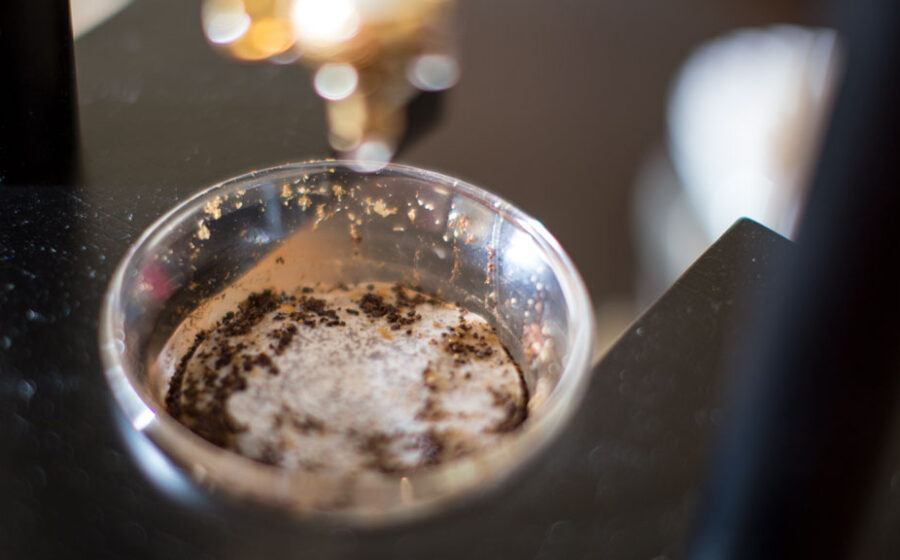[C]old brewing is an extraction method with one arm tied behind its back. Without the high temperatures used to make hot-brewed coffee, cold brewing lacks an essential catalyst that drives extraction in traditional brewing methods. While flavor compounds can still be pulled from coffee with cold—or warm—water, cold brewing requires a much longer exposure time to achieve similar levels of extraction.
“Water has a critical role in enjoying that great cup of coffee,” says Maya Zuniga, science wiz and director of product innovation for S&D Coffee and Tea. “It’s one big chemistry reaction.” Zuniga says that water is just as critical in defining your final cup quality as the actual coffee being used—a sentiment echoed by members throughout the specialty coffee industry.
Hot-brewed coffee benefits from established specifications for water, roasting, brewing, cupping, and green coffee. But in the absence of heat, industry specifications no longer apply. When it comes to cold-brew, there’s no consensus on best practices for brewing, or even specified quality standards. “Cold-brew is still somewhat in its infancy,” Zuniga says. “Everything from defining it to seeing where the points of consistency are—the best practices haven’t yet been developed.”
For the time being, cold brewers are left to their own devices when it comes to figuring out what works for their region and product. Take, for instance, cupping. The SCAA specifies that coffee be cupped at a temperature of 200 degrees (plus or minus 2 degrees), brewed for eight to twelve minutes, eight to twenty-four hours after the coffee is roasted. These guidelines are hardly applicable to cold-brew: the temperature is far too high, the brew time far too short, and many cold-brew recipes call for twenty-four-hour steeping times, making it nearly impossible to meet the suggested roasting window.
There’s so much room for experimentation and creativity in the way you use your water.
Erin Williamson, owner of Pier Coffee, takes an optimistic view of cold-brew’s infancy. “There’s so much room for experimentation and creativity in the way you use your water.” Pier Coffee shares a space with a brewery in Seattle, and Williamson sees the challenge of manipulating water for optimal beer brewing much the same as cold-brew. “I tend more towards the beer side and use the water coming in and then adjust.” She adds that using water similar to the local source gives her cold-brew a local connection.
Williamson finds that a water with higher general hardness yields a more desirable extraction for a cold-brew process. Without the assistance of high temperatures, “there’s so much work the water actually has to do,” she says. With higher mineral content, more metal ions are present to pull flavor into the coffee as it brews. She points to the success of cold-brew in Texas, where the incoming water is naturally high in dissolved minerals.
There’s still no rule that says water for cold-brew must be hard, but knowing the source and makeup of your water matters just as much in cold brewing as in hot. Water sources change by season in some regions, posing additional challenges for roasters and cold brewers. Williamson checks in with local water officials to find out when regional water sources will shift in order to adjust her preparation methods accordingly.
Zuniga advises that cold brewers pay close attention to the cleanliness of their water, as well as its mineral makeup. While hot brewing temperatures typically are high enough to kill off anything that could harm coffee from a food safety standpoint, cold-brew is more vulnerable to bacterial growth. Zuniga says there are many ways to achieve clean water, whether you start with bottled water, distilled water, use filtration systems, or boil water before brewing. (Keep in mind that some of these methods alter the mineral content of water, posing implications on extraction.)
Though the parameters governing cold brewing differ from those of coffee prepared at hot temperatures, the role of water in extraction is still paramount. Like Zuniga, Williamson advocates that water be viewed with equal importance to green coffee. “In coffee we pay so much attention to sourcing coffee—we should pay equal attention to sourcing water, in terms of taste and sustainability.”
—Ellie Bradley is Fresh Cup‘s associate editor.







